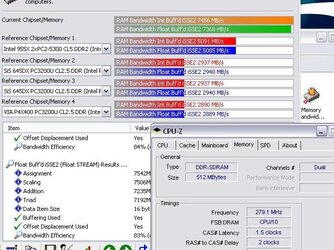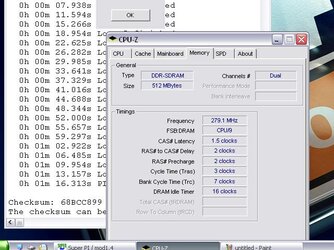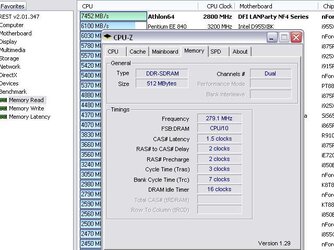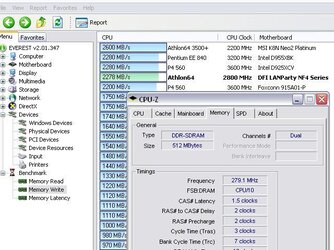The goal of this project, is to take my BH-5 based system memory as far as it will go with complete stability. In this thread, you will see no unstable results that are not labelled as such - the distinction between complete stability, peak screenshot speeds, and peak useable (bencheable) speeds shall be made very clear.
To accomplish this goal, I will be doing a variety of modifications, tweaks, and cooling enhancements to the memory itself, and to my motherboard.
I am doing this mostly for the fun of it, as well as out of curiosity. Hopefully, by the end of this project, some of my questions will have been answered through firsthand results and through firsthand gains...
Is our BH-5 memory held back by the IC itself? Is it held back be heat as a result of extremely high overvoltages, or is it held back by the older JEDEC-Standardized memory PCBs that BH-5 commonly comes on? At how high a VDIMM will the memory continue to see stable overclock gains? Can I crack a 300 MHz 1.5-2-2-3 CPU-Z screenshot with this machine, and with this memory?
The memory on the workbench is my Corsair XMS PC3500 BH-5 based memory. This is a 2x256 meg set of RAM that I use for absolutely everything - gaming, benchmarking, work, internet browsing. I have been running this RAM at 3.78V of VDIMM for say-to-day use since I got this computer onto it's feet.
To start out with pre-project results, without any modifications the memory is completely stable at 273 MHz 1.5-2-2-3, with 3.78V of VDIMM, and a single 80mm fan blowing over the sticks.
Our testbed is my A64 machine, a 3700+ San Diego and a DFI nForce4 motherboard. The memory is actively cooled by a single 80mm fan which is installed onto the memory slots with a homemade fan clip.
I ordered a set of 16 system Memory IC sized copper heatsinks about a week ago, they arrived on Friday.
Before the RAMSinks were installed on this memory, the sticks peaked at 273 MHz, using 1.5-2-2-3 timings, for 24/7 stability across memtest86, Prime95, and 3DMark. The memory peaked at a benchmark-useable (unstable) speed of 275 MHz. A VDIMM voltage of 3.78V (Measured with a multimeter) was required for these overclocks.
After the RAMSinks were installed, the memory saw 5 MHz in gains to it's 24/7 stable overclock - 278 MHz 1.5-2-2-3 is now completely stable across memtest86, Prime95, and 3DMark with the same VDIMM voltage of 3.78V.
This gain, while marginal, is impressive in the sense that it took the memory past it's previous peak-useable speed, but with complete stability. In the grand scope of things, 5 MHz is not a whole lot, making the RAMsinks quite an un-cost-effective means to get more from your memory - but signifigant gains were present.
The peak benchmark useable speed was increased to the same degree that the peak stable speed was increased - the sticks are now benchmark useable to 280 MHz, and can be run through EVEREST and Sandra as far as 282 MHz.
An other effect of the RAMsinks, is that the memory now appears to continue seeing gains when run at higher VDIMM overvoltages. Previously, a VDIMM above 3.78V (with 3.9V being the next step my motherboard made available to me) would adversely affect the stability of any given memory overclock - the RAM would lose an edge when given more voltage.
Apparantly this was due to the increase in heat as a result of overvoltage outweighing the benefit of the overvoltage itself - with the RAMSinks installed the memory now sees gains when run at 3.9V of VDIMM (My DFI nForce4 motherboard overvolts the VDIMM that is set within the BIOS - 3.7V in the BIOS becomes 3.78V when checked with a Multimeter, 3.8V in the BIOS becomes 3.9V when checked with a Multimeter.).
While I have not extensively tested the Windows-based stability gains at 3.9V (I am wary of running the RAM at such a high overvoltage for extended time periods, although it is the memory PCB rather than the BH-5 ICs that I am concerned about), the memory generates fewer errors per pass in memtest86 when run at an unstable clockspeed. At 3.9V, 279 MHz is stable in memtest86 test #5 for half an hour, which is as long as I ran it for. A 1 MHz gain from a .12V overvolt is very, very, very bad voodoo . Generally, when diminishing returns have kicked in to such a strong degree it is a good indication of an unsafely high overvolt.
. Generally, when diminishing returns have kicked in to such a strong degree it is a good indication of an unsafely high overvolt.
Here's a shot of the heatsinks installed on the sticks (The heatsinks were actually slightly smaller than the memory ICs... ThermalTake has once again produced an imperfect product ):
):
To accomplish this goal, I will be doing a variety of modifications, tweaks, and cooling enhancements to the memory itself, and to my motherboard.
I am doing this mostly for the fun of it, as well as out of curiosity. Hopefully, by the end of this project, some of my questions will have been answered through firsthand results and through firsthand gains...
Is our BH-5 memory held back by the IC itself? Is it held back be heat as a result of extremely high overvoltages, or is it held back by the older JEDEC-Standardized memory PCBs that BH-5 commonly comes on? At how high a VDIMM will the memory continue to see stable overclock gains? Can I crack a 300 MHz 1.5-2-2-3 CPU-Z screenshot with this machine, and with this memory?
The memory on the workbench is my Corsair XMS PC3500 BH-5 based memory. This is a 2x256 meg set of RAM that I use for absolutely everything - gaming, benchmarking, work, internet browsing. I have been running this RAM at 3.78V of VDIMM for say-to-day use since I got this computer onto it's feet.
To start out with pre-project results, without any modifications the memory is completely stable at 273 MHz 1.5-2-2-3, with 3.78V of VDIMM, and a single 80mm fan blowing over the sticks.
Our testbed is my A64 machine, a 3700+ San Diego and a DFI nForce4 motherboard. The memory is actively cooled by a single 80mm fan which is installed onto the memory slots with a homemade fan clip.
I ordered a set of 16 system Memory IC sized copper heatsinks about a week ago, they arrived on Friday.
Before the RAMSinks were installed on this memory, the sticks peaked at 273 MHz, using 1.5-2-2-3 timings, for 24/7 stability across memtest86, Prime95, and 3DMark. The memory peaked at a benchmark-useable (unstable) speed of 275 MHz. A VDIMM voltage of 3.78V (Measured with a multimeter) was required for these overclocks.
After the RAMSinks were installed, the memory saw 5 MHz in gains to it's 24/7 stable overclock - 278 MHz 1.5-2-2-3 is now completely stable across memtest86, Prime95, and 3DMark with the same VDIMM voltage of 3.78V.
This gain, while marginal, is impressive in the sense that it took the memory past it's previous peak-useable speed, but with complete stability. In the grand scope of things, 5 MHz is not a whole lot, making the RAMsinks quite an un-cost-effective means to get more from your memory - but signifigant gains were present.
The peak benchmark useable speed was increased to the same degree that the peak stable speed was increased - the sticks are now benchmark useable to 280 MHz, and can be run through EVEREST and Sandra as far as 282 MHz.
An other effect of the RAMsinks, is that the memory now appears to continue seeing gains when run at higher VDIMM overvoltages. Previously, a VDIMM above 3.78V (with 3.9V being the next step my motherboard made available to me) would adversely affect the stability of any given memory overclock - the RAM would lose an edge when given more voltage.
Apparantly this was due to the increase in heat as a result of overvoltage outweighing the benefit of the overvoltage itself - with the RAMSinks installed the memory now sees gains when run at 3.9V of VDIMM (My DFI nForce4 motherboard overvolts the VDIMM that is set within the BIOS - 3.7V in the BIOS becomes 3.78V when checked with a Multimeter, 3.8V in the BIOS becomes 3.9V when checked with a Multimeter.).
While I have not extensively tested the Windows-based stability gains at 3.9V (I am wary of running the RAM at such a high overvoltage for extended time periods, although it is the memory PCB rather than the BH-5 ICs that I am concerned about), the memory generates fewer errors per pass in memtest86 when run at an unstable clockspeed. At 3.9V, 279 MHz is stable in memtest86 test #5 for half an hour, which is as long as I ran it for. A 1 MHz gain from a .12V overvolt is very, very, very bad voodoo
Here's a shot of the heatsinks installed on the sticks (The heatsinks were actually slightly smaller than the memory ICs... ThermalTake has once again produced an imperfect product
 ):
):Attachments
Last edited:
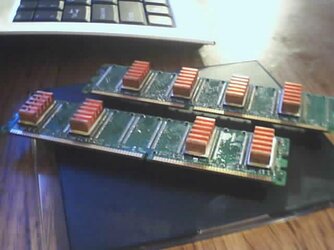
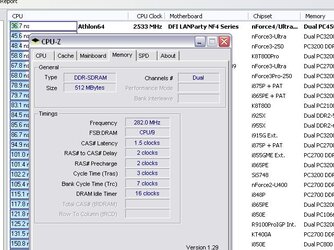
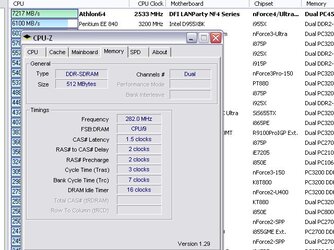
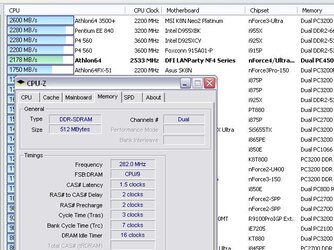
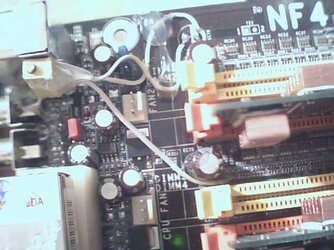
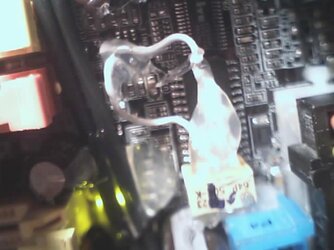
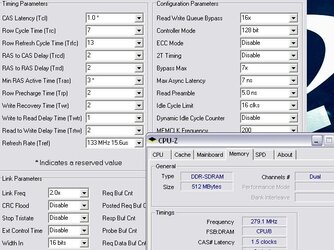
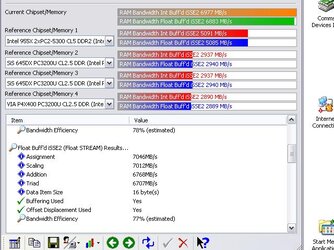
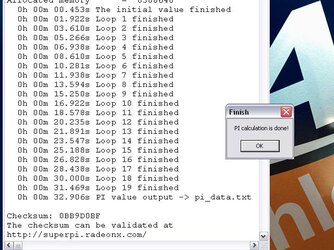
 I've only dreamt of getting mine up that high.
I've only dreamt of getting mine up that high. 

